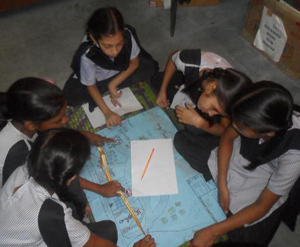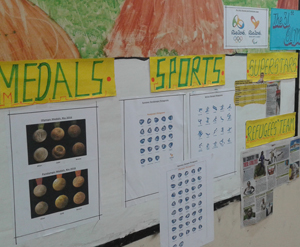The Resource Room approach has been designed and developed by me since 2012, based on my study of key educational methodologies, as also my experiences of working with children largely between 9 – 12 years of age.
This section presents the key elements of the Resource Room approach.
- We will be regular and punctual to class
- We will do our work with commitment and understanding
- We will take care of ourselves, each other, and our surroundings


Taking good care of our resources!
In the Resource Room, the children make their own Work Groups, based on their choice of partners. In a multi-grade environment, the Work Groups could comprise children across different grades.


Working together – more learning, more fun!
Each Work Group formulates its own Work Plan, by choosing specific learning tasks which the group members would like to engage with. The children choose these tasks from a collection of learning material that is made available to them, across a range of subject-areas. The Resource Room teacher guides each Work Group through the process of making the Work Plan. The choice with regards to which specific tasks to take, however, is left largely with the children.
The Work Reviews are held at regular and pre-decided intervals of time. This is when the children and the Resource Room teacher come together to reflect on the work that has been done so far and also renew the Work Plan. This is a critical work process, which aims to strengthen ‘self-direction/regulation of learning’.
Here we look at questions such as, what did we learn through this task, what did we find difficult, how did we resolve our difficulties, what did we enjoy in this task, how are we doing as a Work Group, any issues we need to talk about, a review of the Work Norms and a self-reflection on how each of us is doing on the same.

Learning to make thoughtful choices – a ‘Work Planning’ session in progress

Work Plans!


Notes to myself!
This is when the children and the Resource Room teachers sit silently at the very beginning of the class, with a piece of instrumental music (audio/video) playing in the background. This activity helps everyone settle down, and focus on the work ahead. It also offers all present a sense of calm and quietness both, in body and mind.
It also helps enhance one’s knowledge and understanding of Indian and Western Classical music, as the class listens to a variety of music during this activity, and talks about the instruments, musicians and composers that they are listening to.

A few moments with oneself, and music.

Exploring the world of music!
To put it simply, most of the times, we tend to follow the following approach in our work in the Resource Room,
- Step 1 – Study the chosen learning material
- Step 2 – Conduct further explorations, in line with the children’s inquires
- Step 3 – Express the learning in an effective and creative manner
- Step 4 – Share the learning with others
While facilitating the above, the Resource Room teachers try and keep the following elements (CRIAM) alive in the children’s work,
- C – the children’s choice
In order to enable children to discover and explore their true and natural interests and inquires - R – connect to real-life
In order to enable children to use their knowledge to engage more deeply and meaningfully with their life experiences - I – integration across subject-areas, as also art / music / dramatics and so on
In order to facilitate a deeper, fuller and thus more meaningful understanding and expression of the concept/theme under discussion - A – activity-based learning
In order to deepen one’s understanding of the concept/theme under discussion, by exploring it through application and experimentation - M – moderation of learning objectives
In order to align the learning experience with the child’s current and evolving abilities, thus making the experience more effective and meaningful for the child






Working together – more learning, more fun!
This is an opportunity for both the Resource Room teachers and the children, to bring to class, something that they like and find interesting, and talk about the same. All kinds of things are welcome, from natural things like stones, shells and feathers, to hand-made art and craft items, to other kinds of interesting things like coins, toys and so on.
Through this activity both the children and the Resource Room teachers, get to learn about, observe and appreciate many different kinds-of things, and it also gives them an opportunity to talk to the rest of the class about something that is of value and interest to them.


Our very own treasure-trove!
This activity aims to encourage and facilitate the children’s natural curiosity, and their eagerness to find answers to the many questions that intrigue them. The children put-in their questions in the ‘I Wonder Box’, and then together with the help of the Resource Room teachers and their fellow-students, try to find answers to the same.


Why, What, When, Where, How… ??
This is where the class as a whole, explores a particular theme in detail. The topic under discussion could be proposed by the Resource Room teachers or the children, or it could be guided by what is topical and significant at that moment in time. This activity provides the opportunity to understand many unfamiliar and intriguing topics in great depth.

Handmade musical instruments – wind, string and percussion!

Learning about the Olympics!
Quite often, once a Work Group completes a particular task, they present their work to the rest of the class. Doing so helps everyone learn from each other, while also making the presenters more confident of their own learning. It also enables the children, to become more comfortable and effective with regards to sharing their thoughts, experiences and learning with others.


Sharing and Learning!
- Committing oneself to the same Work Norms
- Enabling a positive and productive work environment
- Equipping and maintaining the RR
- Serving as a resource for the children
- Challenging and supporting children, as required


Teachers and Students – partners at work!